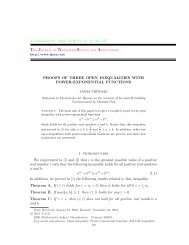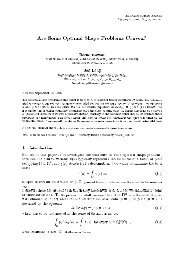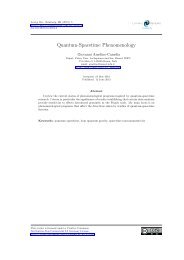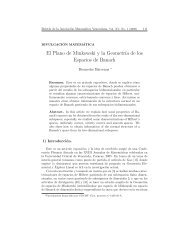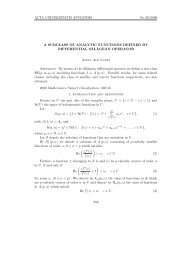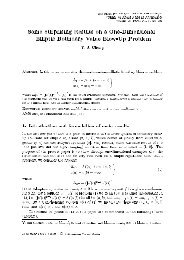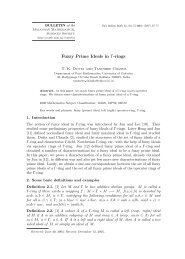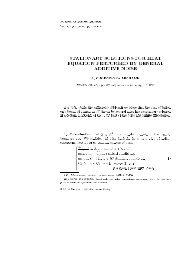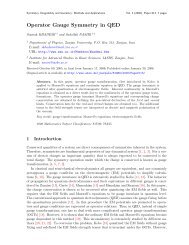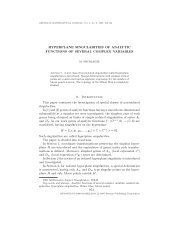on a certain class of harmonic multivalent functions
on a certain class of harmonic multivalent functions
on a certain class of harmonic multivalent functions
You also want an ePaper? Increase the reach of your titles
YUMPU automatically turns print PDFs into web optimized ePapers that Google loves.
J. N<strong>on</strong>linear Sci. Appl. 4 (2011), no. 2, 170–179<br />
The Journal <strong>of</strong> N<strong>on</strong>linear Science and Applicati<strong>on</strong>s<br />
http://www.tjnsa.com<br />
ON A CERTAIN CLASS OF HARMONIC MULTIVALENT<br />
FUNCTIONS<br />
SAURABH PORWAL 1 , POONAM DIXIT 2,∗ AND VINOD KUMAR 3<br />
Dedicated to Themistocles M. Rassias <strong>on</strong> the occasi<strong>on</strong> <strong>of</strong> his sixtieth birthday<br />
Communicated by Cho<strong>on</strong>kil Park<br />
Abstract. The purpose <strong>of</strong> the present paper is to study some results involving<br />
coefficient c<strong>on</strong>diti<strong>on</strong>s, extreme points, distorti<strong>on</strong> bounds, c<strong>on</strong>voluti<strong>on</strong><br />
c<strong>on</strong>diti<strong>on</strong>s and c<strong>on</strong>vex combinati<strong>on</strong> for a new <strong>class</strong> <strong>of</strong> harm<strong>on</strong>ic <strong>multivalent</strong><br />
functi<strong>on</strong>s in the open unit disc. Relevant c<strong>on</strong>necti<strong>on</strong>s <strong>of</strong> the results presented<br />
here with various known results are briefly indicated.<br />
1. Introducti<strong>on</strong><br />
A c<strong>on</strong>tinuous complex-valued functi<strong>on</strong> f = u+iv defined in a simply c<strong>on</strong>nected<br />
domain D is said to be harm<strong>on</strong>ic in D if both u and v are real harm<strong>on</strong>ic in D. In<br />
any simply c<strong>on</strong>nected domain we can write f = h + g, where h and g are analytic<br />
in D. We call h the analytic part and g the co-analytic part <strong>of</strong> f.<br />
A necessary and sufficient c<strong>on</strong>diti<strong>on</strong> for f to be locally univalent and sensepreserving<br />
in D is that |h ′ (z)| > |g ′ (z)|, z ∈ D. See Clunie and Shiel-Small [7],<br />
(see also Ahuja [1] and Duren [11].)<br />
Let H denotes the <strong>class</strong> <strong>of</strong> functi<strong>on</strong>s f = h + g which are harm<strong>on</strong>ic univalent<br />
and sense-preserving in the open unit disk U = {z : |z| < 1} for which f (0) =<br />
f z (0) − 1 = 0. Then for f = h + g ∈ S H we may express the analytic functi<strong>on</strong>s<br />
h and g as<br />
∞∑<br />
∞∑<br />
h(z) = z + a k z k , g(z) = b k z k , |b 1 | < 1. (1.1)<br />
k=2<br />
Date: Received: August 27, 2010; Revised: November 29, 2010.<br />
∗ Corresp<strong>on</strong>ding author<br />
c○ 2011 N.A.G.<br />
2000 Mathematics Subject Classificati<strong>on</strong>. Primary 30C45, 30C50, 30C55.<br />
Key words and phrases. Harm<strong>on</strong>ic; Univalent; Multivalent functi<strong>on</strong>s; Fracti<strong>on</strong>al calculus.<br />
170<br />
k=1
HARMONIC MULTIVALENT FUNCTIONS 171<br />
Recently, Ahuja and Jahangiri [3] defined the <strong>class</strong><br />
H p (k) , (p, k ∈ N = {1, 2, 3....})<br />
c<strong>on</strong>sisting <strong>of</strong> all p-valent harm<strong>on</strong>ic functi<strong>on</strong>s f = h+g which are sense-preserving<br />
in U and h and g are <strong>of</strong> the form<br />
∞∑<br />
∞∑<br />
h(z) = z p + a k+p−1 z k+p−1 , g(z) = b k+p−1 z k+p−1 , |b p | < 1. (1.2)<br />
k=2<br />
Note that H and H p (k) reduce to the <strong>class</strong> S and S p (k) <strong>of</strong> analytic univalent<br />
and <strong>multivalent</strong> functi<strong>on</strong>s, respectively, if the co-analytic part <strong>of</strong> its members are<br />
zero. For these <strong>class</strong>es f (z) may be expressed as<br />
and<br />
f(z) = z +<br />
f(z) = z p +<br />
k=1<br />
∞∑<br />
a k z k , (1.3)<br />
k=2<br />
∞∑<br />
a k+p−1 z k+p−1 . (1.4)<br />
k=2<br />
The following definiti<strong>on</strong>s <strong>of</strong> fracti<strong>on</strong>al integrals and fracti<strong>on</strong>al derivatives are<br />
due to Owa [17] and Srivastava and Owa [23].<br />
Definiti<strong>on</strong> 1.1. The fracti<strong>on</strong>al integral <strong>of</strong> order λ is defined for a functi<strong>on</strong> f (z)<br />
by<br />
Dz −λ f(z) = 1 ∫ z<br />
f(ς)<br />
dς, (1.5)<br />
Γλ<br />
1−λ<br />
0 (z − ς)<br />
where λ > 0, f (z) is an analytic functi<strong>on</strong> in a simply c<strong>on</strong>nected regi<strong>on</strong> <strong>of</strong> the<br />
z-plane c<strong>on</strong>taining the origin and the multiplicity <strong>of</strong> (z − ς) λ−1 is removed by<br />
requiring log (z − ς) to be real when (z − ς) > 0.<br />
Definiti<strong>on</strong> 1.2. The fracti<strong>on</strong>al derivative <strong>of</strong> order λ is defined for a functi<strong>on</strong><br />
f (z) by<br />
D λ z f(z) =<br />
1 d<br />
Γ (1 − λ) dz<br />
∫ z<br />
0<br />
f(ς)<br />
dς, (1.6)<br />
λ<br />
(z − ς)<br />
where 0 ≤ λ < 1, f (z) is an analytic functi<strong>on</strong> in a simply c<strong>on</strong>nected regi<strong>on</strong> <strong>of</strong><br />
the z-plane c<strong>on</strong>taining the origin and the multiplicity <strong>of</strong> (z − ς) −λ is removed as<br />
in Definiti<strong>on</strong> 1.1 above.<br />
Definiti<strong>on</strong> 1.3. Under the hypothesis <strong>of</strong> Definiti<strong>on</strong> 1.2 the fracti<strong>on</strong>al derivative<br />
<strong>of</strong> order n + λ is defined for a functi<strong>on</strong> f (z) by<br />
where 0 ≤ λ < 1 and n ∈ N 0 = {0, 1, 2.....}.<br />
Dz<br />
n+λ f(z) = dn<br />
dz n Dλ z f(z), (1.7)
172 S. PORWAL, P. DIXIT, V. KUMAR<br />
Motivated with the definiti<strong>on</strong> <strong>of</strong> Salagean operator, we introduced an interesting<br />
operator (Dz λ,p ) n f(z) for functi<strong>on</strong> f(z) <strong>of</strong> the form (1.4)<br />
Thus we have<br />
(D λ,p<br />
z ) 0 f(z) =<br />
(Dz<br />
λ,p ) 1 f(z) = z p<br />
(D λ,p<br />
z<br />
(D λ,p<br />
z ) n f(z) = z p +<br />
= z p +<br />
Γ(p − λ + 1)<br />
z λ Dz λ f(z)<br />
Γ(p + 1)<br />
( Γ (p − λ + 1)<br />
Γ (p + 1)<br />
) n f(z) = (D λ,p )((D λ,p ) n−1 f(z)).<br />
z<br />
z<br />
) ′<br />
z λ Dz λ f (z)<br />
∞∑<br />
( ) n (k + p − 1)Γ (p − λ + 1) Γ (k + p)<br />
a k+p−1 z k+p−1<br />
pΓ (p + 1) Γ (k + p − λ)<br />
∞∑<br />
(ϕ (k, p, λ)) n a k+p−1 z k+p−1 (1.8)<br />
k=2<br />
k=2<br />
where and throughout this paper<br />
ϕ(k, p, λ) =<br />
kΓ(p − λ + 1)Γ(k + p)<br />
Γ(p + 1)Γ(k + p − λ)<br />
(k, p ∈ N). (1.9)<br />
Now, we define (Dz<br />
λ,p ) n f(z) for functi<strong>on</strong> <strong>of</strong> the form (1.2) as follows<br />
(D λ,p<br />
z<br />
) n f(z) = (D λ,p ) n h(z) + (−1) n (Dz λ,p ) n g(z). (1.10)<br />
z<br />
We note that the study <strong>of</strong> the above operator (Dz<br />
λ,p ) n is <strong>of</strong> special interest<br />
because it includes a variety <strong>of</strong> well-known operator. For example<br />
1. If we put n = 0, p = 1 then it reduces to Owa-Srivastava Operator.<br />
2. If we put λ = 0, then it reduces to well-known and widely used Salagean<br />
Operator [19].<br />
Now for<br />
m ∈ N, n ∈ N 0 , m > n, 0 ≤ γ < 1, β ≥ 0, 0 ≤ λ < 1, 0 ≤ t ≤ 1, α ∈ R<br />
and z ∈ U, suppose that H p (m, n; β; γ; t; λ) denote the family <strong>of</strong> harm<strong>on</strong>ic functi<strong>on</strong>s<br />
f <strong>of</strong> the form (1.2) such that<br />
}<br />
Re<br />
{(1 + βe iα ) (Dλ,p z ) m f(z)<br />
(Dz λ,p ) n f t (z) − βeiα ≥ γ, (1.11)<br />
where (Dz<br />
λ,p ) m f(z) is defined by (1.10) and f t (z) = (1 − t)z + t(h(z) + g(z)).<br />
Further, let the sub<strong>class</strong> H p (m, n; β; γ; t; λ) c<strong>on</strong>sisting <strong>of</strong> harm<strong>on</strong>ic functi<strong>on</strong>s<br />
f m = h + g m in H p (m, n; β; γ; t; λ) so that h and g m are <strong>of</strong> the form<br />
∞∑<br />
∑ ∞<br />
h(z) = z p − |a k+p−1 | z k+p−1 , g m (z) = (−1) m−1 |b k+p−1 | z k+p−1 , |b p | < 1.<br />
k=2<br />
(1.12)<br />
By specializing the parameters in sub<strong>class</strong> H p (m, n; β; γ; t; λ), we obtain the<br />
following known sub<strong>class</strong>es studied earlier by various authors.<br />
(1) H p (m, n; 0; γ; 1; 0) ≡ H p (m, n; γ) and H p (m, n; 0; γ; 1; 0) ≡ H p (m, n; γ)<br />
studied by Sker and Eker [20].<br />
k=1
HARMONIC MULTIVALENT FUNCTIONS 173<br />
(2) H p (n + 1, n; 1; γ; 1; 0) ≡ H p (n, γ) and H p (n + 1, n; 1; γ; 1; 0) ≡ H p (n, γ)<br />
studied by Dixit et al. [9].<br />
(3) H p (1, 0; 0; γ; 1; 0) ≡ H p (γ) and H p (1, 0; 0; γ; 1; 0) ≡ H p (γ) studied by<br />
Ahuja and Jahangiri [3].<br />
(4) H 1 (n + q, n, p, γ, 1, 0) ≡ R H (n, γ, p, q) studied by Dixit et al. [8].<br />
(5) H 1 (n+1, n, 1, γ, 1, 0) ≡ RS H (n, γ) and H 1 (n+1, n, 1, γ, 1, 0) ≡ RS H (n, γ)<br />
studied by Yalcin et al. [25].<br />
(6) H 1 (1, 0, 1, γ, 1, 0) ≡ G H (γ) and H 1 (1, 0, 1, γ, 1, 0) ≡ G H (γ) studied by<br />
Rosy et al. [18].<br />
(7) H 1 (2, 1, β, γ, 1, 0) ≡ HCV (β, γ) and H 1 (2, 1, β, γ, 1, 0) ≡ HCV (β, γ) studied<br />
by Kim et al. [15].<br />
(8) H 1 (1, 0, β, γ, t, 0) ≡ G H (β, γ, t) and H 1 (1, 0, β, γ, t, 0) ≡ G H (β, γ, t) studied<br />
by Ahuja et al. [2].<br />
(9) H 1 (m, n; 0; γ; 1; 0) ≡ S H (m, n; γ) and H 1 (m, n; 0; γ; 1; 0) ≡ S H (m, n; γ)<br />
studied by Yalcin [24].<br />
(10) H 1 (n + 1, n; 0; γ; 1; 0) ≡ H(n, γ) and H 1 (n + 1, n; 0; γ; 1; 0) ≡ H(n, γ)<br />
studied by Jahangiri et al. [13].<br />
(11) H 1 (1, 0; 0; γ; t; λ) ≡ SH ∗ (γ, t, λ) and H 1(1, 0; 0; γ; t; λ) ≡ SH ∗ (γ, t, λ) studied<br />
by Kumar et al. [16].<br />
(12) H 1 (1, 0; 0; γ; 1; λ) ≡ SH ∗ (γ, λ) and H 1(1, 0; 0; γ; 1; λ) ≡ T SH ∗ (γ, λ) studied<br />
by Dixit and Porwal [10].<br />
(13) H 1 (2, 1; 0; γ; 1; 0) ≡ HK(γ) and H 1 (1, 0; 0; γ; 1; 0) ≡ SH ∗ (γ) studied by<br />
Jahangiri [12].<br />
(14) H 1 (2, 1; 0; 0; 1; 0) ≡ HK(0) and H 1 (2, 1; 0; 0; 1; 0) ≡ SH ∗ (0) studied by Avci<br />
and Zlotkiewicz [6], Silverman [21] and Silverman and Silvia [22].<br />
(15) H 1 (1, 0, 0, γ, 0, 0) ≡ N H (γ) studied by Ahuja and Jahangiri [4].<br />
(16) S p (1, 0, k, 0, 1, 0) ≡ k − ST studied by Aouf [5], see also Kanas and Srivastava<br />
[14].<br />
In the present paper, results involving the coefficient c<strong>on</strong>diti<strong>on</strong>, extreme points,<br />
distorti<strong>on</strong> bounds, c<strong>on</strong>voluti<strong>on</strong> and c<strong>on</strong>vex combinati<strong>on</strong>s for the above <strong>class</strong>es<br />
H p (m, n, β, γ, tλ) and H p (m, n, β, γ, t, λ) <strong>of</strong> harm<strong>on</strong>ic <strong>multivalent</strong> functi<strong>on</strong>s have<br />
been investigated.<br />
2. Main results<br />
In our first theorem, we introduce a sufficient c<strong>on</strong>diti<strong>on</strong> for functi<strong>on</strong>s in H p (m, n, β, γ, t, λ).<br />
Theorem 2.1. Let f = h+g be such that h and g are given by (1.2). Furthermore,<br />
let<br />
∞∑<br />
{ψ(m, n, β, γ, t, λ)|a k+p−1 | + Θ(m, n, β, γ, t, λ)|b k+p−1 |} ≤ 2, (2.1)<br />
where<br />
k=1<br />
ψ(m, n, β, γ, t, λ) = (ϕ(k, p, λ))m (1 + β) − t(β + γ)(ϕ(k, p, λ)) n<br />
,<br />
1 − γ
174 S. PORWAL, P. DIXIT, V. KUMAR<br />
and<br />
Θ(m, n, β, γ, t, λ) = (ϕ(k, p, λ))m (1 + β) − (−1) m−n t(β + γ)(ϕ(k, p, λ)) n<br />
,<br />
1 − γ<br />
a p = 1, m ∈ N, n ∈ N 0 , m > n, 0 ≤ γ < 1, β ≥ 0, 0 ≤ λ < 1 and 0 ≤ t ≤ 1,<br />
then f is sense-preserving in U and f ∈ H p (m, n, β, γ, t, λ).<br />
Pro<strong>of</strong>. Using the fact that Re ω ≥ γ if and <strong>on</strong>ly if |1 − γ + ω| ≥ |1 + γ − ω|, it<br />
suffices to show that<br />
|(1 − γ)(D λ,p<br />
z<br />
−|(1 + γ)(D λ,p<br />
z<br />
Substituting for (D λ,p<br />
z<br />
∣ (2 − γ)zp +<br />
+(−1) n<br />
−<br />
∣ γzp +<br />
+(−1) n<br />
∞<br />
∑<br />
k=1<br />
) n f t (z) + (1 + βe iα )(D λ,p ) m f(z) − βe iα (D λ,p ) n f t (z)|<br />
z<br />
) n f t (z) − (1 + βe iα )(Dz<br />
λ,p ) m f(z) + βe iα (Dz λ,p ) n f t (z)|. (2.2)<br />
) m f(z) and (D λ,p ) n f t (z) in L.H.S. <strong>of</strong> (2.2), we have<br />
z<br />
∞∑<br />
[(1 − γ − βe iα )(ϕ(k, p, λ)) n t + (1 + βe iα )(ϕ(k, p, λ)) m ] a k+p−1 z k+p−1<br />
k=2<br />
[(1 − γ − βe iα )(ϕ(k, p, λ)) n t + (−1) m−n (1 + βe iα )(ϕ(k, p, λ)) m ]b k+p−1¯z k+p−1 ∣ ∣∣∣∣<br />
∞∑<br />
[(1 + γ + βe iα )(ϕ(k, p, λ)) n t − (1 + βe iα )(ϕ(k, p, λ)) m ] a k+p−1 z k+p−1<br />
k=2<br />
∑ ∞<br />
k=1<br />
≥ 2(1 − γ)|z| p − 2<br />
−<br />
−<br />
[(1 + γ + βe iα )(ϕ(k, p, λ)) n t − (−1) m−n (1 + βe iα )(ϕ(k, p, λ)) m ]b k+p−1¯z k+p−1 ∣ ∣∣∣∣<br />
∞∑<br />
[(ϕ(k, p, λ)) m (1 + β) − (γ + β)t(ϕ(k, p, λ)) n ]|a k+p−1 ||z| k+p−1<br />
k=2<br />
∞∑<br />
|[(1 − γ)(ϕ(k, p, λ)) n t + (−1) m−n (1 + βe iα )(ϕ(k, p, λ)) m − βe iα (ϕ(k, p, λ)) n t]||b k+p−1 ||z| k+p−1<br />
k=1<br />
∞∑<br />
|[(−1) m−n (1 + βe iα )(ϕ(k, p, λ)) m − (1 + γ + βe iα )(ϕ(k, p, λ)) n t]||b k+p−1 ||z| k+p−1<br />
k=1<br />
z<br />
⎧<br />
⎪⎨<br />
=<br />
⎪⎩<br />
∞∑<br />
2(1 − γ)|z| p − 2 [(1 + β)(ϕ(k, p, λ)) m − (γ + β)t(ϕ(k, p, λ)) n ]|a k+p−1 ||z| k+p−1<br />
−2<br />
k=2<br />
∞∑<br />
[(1 + β)(ϕ(k, p, λ)) m + (γ + β)t(ϕ(k, p, λ)) n ]|b k+p−1 ||z| k+p−1 , if m − n is odd<br />
k=2<br />
2(1 − γ)|z| p − 2<br />
−2<br />
∞∑<br />
[(1 + β)(ϕ(k, p, λ)) m − (γ + β)t(ϕ(k, p, λ)) n ]|a k+p−1 ||z| k+p−1<br />
k=2<br />
∞∑<br />
[(1 + β)(ϕ(k, p, λ)) m − (γ + β)t(ϕ(k, p, λ)) n ]|b k+p−1 ||z| k+p−1 , if m − n is odd<br />
k=1
HARMONIC MULTIVALENT FUNCTIONS 175<br />
∞∑<br />
= 2(1 − γ)|z|<br />
{1 p (ϕ(k, p, λ)) m (1 + β) − (γ + β)t(ϕ(k, p, λ)) n<br />
−<br />
|a k+p−1 ||z| k−1<br />
1 − γ<br />
k=2<br />
∞∑<br />
}<br />
(ϕ(k, p, λ)) m (1 + β) − (−1) m−n (γ + β)t(ϕ(k, p, λ)) n<br />
−<br />
|b k+p−1 ||z| k−1<br />
1 − γ<br />
k=1<br />
{ ∞∑ (ϕ(k, p, λ)) m (1 + β) − (γ + β)t(ϕ(k, p, λ)) n<br />
> 2(1 − γ) 1 −<br />
|a k+p−1 |<br />
1 − γ<br />
k=2<br />
∞∑<br />
}<br />
(ϕ(k, p, λ)) m (1 + β) − (−1) m−n (γ + β)t(ϕ(k, p, λ)) n<br />
−<br />
|b k+p−1 | .<br />
1 − γ<br />
k=1<br />
The last expressi<strong>on</strong> is n<strong>on</strong> negative by (2.1), and so the pro<strong>of</strong> is complete.<br />
In the following theorem, it is proved that the c<strong>on</strong>diti<strong>on</strong> (2.1) is also necessary<br />
for functi<strong>on</strong>s f m = h + g m , where h and g m are <strong>of</strong> the form (1.12).<br />
Theorem 2.2. Let f m = h+g m be given by (1.12). Then f m ∈ H p (m, n, β, γ, t, λ),<br />
if and <strong>on</strong>ly if<br />
∞∑<br />
{ψ (m, n, β, γ, t, λ) |a k+p−1 | + Θ (m, n, β, γ, t, λ) |b k+p−1 |} ≤ 2. (2.3)<br />
k=1<br />
Pro<strong>of</strong>. Since H p (m, n; β; γ; t; λ) ⊂ H p (m, n; β; γ; t; λ), we <strong>on</strong>ly need to prove the<br />
“<strong>on</strong>ly if” part <strong>of</strong> the theorem.<br />
To this end, for functi<strong>on</strong>s f m <strong>of</strong> the form (1.12), we notice that c<strong>on</strong>diti<strong>on</strong><br />
⎧<br />
⎨( ) ( )<br />
1 + βe<br />
iα<br />
D λ,p m<br />
f (z)<br />
is equivalent to<br />
⎧<br />
⎪⎨<br />
Re<br />
⎪⎩<br />
(1 − γ)z p −<br />
Re<br />
⎩<br />
(<br />
z<br />
D λ,p<br />
z<br />
) n<br />
ft (z)<br />
− βe iα ⎫<br />
⎬<br />
⎭ ≥ γ<br />
∞∑<br />
[(ϕ(k, p, λ)) m (1 + βe iα ) − (βe iα + γ)(ϕ(k, p, λ)) n t]<br />
k=2<br />
|a k+p−1 |z k+p−1 + (−1) 2m−1<br />
∞∑<br />
[(ϕ(k, p, λ)) m (1 + βe iα ) − (−1) m−n (βe iα + γ)(ϕ(k, p, λ)) n t]<br />
k=1<br />
z −<br />
⎫⎪<br />
|b k+p−1 |¯z k+p−1<br />
⎬<br />
≥ 0.<br />
∞∑<br />
(ϕ (k, p, λ)) n t |a k+p−1 | z k+p−1 + (−1) m+n−1<br />
∞∑<br />
(ϕ (k, p, λ)) n t |b k+p−1 | ¯z k+p−1 ⎪ ⎭<br />
k=2<br />
k=1<br />
□<br />
(2.4)
176 S. PORWAL, P. DIXIT, V. KUMAR<br />
The above required c<strong>on</strong>diti<strong>on</strong> (2.4) must hold for all values <strong>of</strong> z in U. Up<strong>on</strong><br />
choosing the values <strong>of</strong> z <strong>on</strong> the positive real axis where 0 ≤ z = r < 1, we must<br />
have<br />
⎧<br />
∞∑<br />
(1 − γ) − [(ϕ (k, p, λ)) m − γt (ϕ (k, p, λ)) n ] |a k+p−1 | r k−1<br />
⎪⎨<br />
Re<br />
⎪⎩<br />
1 −<br />
−<br />
k=2<br />
∞∑ [<br />
(ϕ (k, p, λ)) m − (−1) m−n γt (ϕ (k, p, λ)) n] |b k+p−1 | r k−1<br />
k=1<br />
∞∑<br />
∑ ∞<br />
(ϕ (k, p, λ)) n t |a k+p−1 | r k−1 − (−1) m−n (ϕ (k, p, λ)) n t |b k+p−1 | r k−1<br />
k=2<br />
k=1<br />
−e iα<br />
−<br />
∞<br />
∑<br />
k=2<br />
β ((ϕ (k, p, λ)) m − t (ϕ (k, p, λ)) n ) |a k+p−1 | r k−1<br />
∞∑<br />
β ( (ϕ (k, p, λ)) m − (−1) m−n t (ϕ (k, p, λ)) n) |b k+p−1 | r k−1<br />
k=1<br />
1 −<br />
⎫⎪ ⎬<br />
≥ 0.<br />
∞∑<br />
(ϕ (k, p, λ)) n t |a k+p−1 | r k−1 − (−1) m−n<br />
∞∑<br />
(ϕ (k, p, λ)) n t |b k+p−1 | r k−1 ⎪ ⎭<br />
k=2<br />
k=1<br />
Since Re (−e iα ) ≥ − |e iα | = −1, the above inequality reduces to<br />
(1 − γ) −<br />
−<br />
1 −<br />
∞∑<br />
[(ϕ (k, p, λ)) m (1 + β) − (β + γ) (ϕ (k, p, λ)) n t] |a k+p−1 | r k−1<br />
k=2<br />
∞∑ [<br />
(ϕ (k, p, λ)) m (1 + β) − (−1) m−n (β + γ) (ϕ (k, p, λ)) n t ] |b k+p−1 | r k−1<br />
k=1<br />
∞∑<br />
∞<br />
≥ 0.<br />
∑<br />
(ϕ (k, p, λ)) n t |a k+p−1 | r k−1 − (−1) m−n (ϕ (k, p, λ)) n t |b k+p−1 | r k−1<br />
k=2<br />
(2.5)<br />
If the c<strong>on</strong>diti<strong>on</strong> (2.3) does not hold, then the numerator in (2.5) is negative<br />
for r sufficiently close to 1. Hence there exists a z 0 = r 0 in (0,1) for which<br />
the quotient in (2.5) is negative. This c<strong>on</strong>tradicts the required c<strong>on</strong>diti<strong>on</strong> for<br />
f m ∈ H p (m, n; β; γ; t; λ) and so the pro<strong>of</strong> is complete.<br />
□<br />
We employ the techniques <strong>of</strong> Dixit et al. [9] in the pro<strong>of</strong>s <strong>of</strong> Theorems 2.3, 2.4,<br />
2.6 and 2.7.<br />
k=1
HARMONIC MULTIVALENT FUNCTIONS 177<br />
Theorem 2.3. Let f m be given by (1.12). Then f m ∈ H p (m, n; β; γ; t; λ), if and<br />
<strong>on</strong>ly if<br />
∞∑ (<br />
f m (z) = xk+p−1 h k+p−1 (z) + y k+p−1 g mk+p−1 (z) ) , where h p (z) = z p ,<br />
k=1<br />
h k+p−1 (z) = z p 1<br />
−<br />
ψ (m, n, β, γ, t, λ) zk+p−1 , (k = 2, 3, 4....) , g mk+p−1 (z) = z p + (−1) m−1<br />
1<br />
Θ (m, n, β, γ, t, λ) ¯zk+p−1 , (k = 1, 2, 3....) , x k+p−1 ≥ 0,<br />
∞∑<br />
y k+p−1 ≥ 0, (x k+p−1 + y k+p−1 ) = 1.<br />
k=1<br />
In particular, the extreme points <strong>of</strong> H p (m, n; β; γ; t; λ) are {h k+p−1 } and {g mk+p−1 }.<br />
Theorem 2.4. Let f m ∈ H p (m, n; β; γ; t; λ). Then for |z| = r < 1 we have<br />
|f m (z)| ≤ (1 + |b p |)r p 1<br />
+ ( )<br />
(p+1) 2 n<br />
⎛<br />
⎜<br />
⎝<br />
and<br />
⎛<br />
⎜<br />
⎝<br />
(<br />
(p+1) 2<br />
p(p−λ+1)<br />
(<br />
(p+1) 2<br />
p(p−λ+1)<br />
1 − γ<br />
) m−n<br />
−<br />
(1 + β) − t(γ + β)<br />
p(p−λ+1)<br />
(1 + β) − (−1) m−n t(γ + β) ⎟<br />
) m−n<br />
|b p | ⎠ r p+1<br />
(1 + β) − t(γ + β)<br />
(<br />
(p+1) 2<br />
p(p−λ+1)<br />
|f m (z)| ≥ (1 − |b p |) r p −<br />
1<br />
(<br />
(p+1) 2<br />
p(p−λ+1)<br />
1 − γ<br />
) m−n<br />
− (1 + β) − (−1)m−n t (γ + β) ⎟<br />
) m−n<br />
|b p | ⎠ r p+1 .<br />
(1 + β) − t (γ + β) (1 + β) − t(γ + β)<br />
(<br />
(p+1) 2<br />
p(p−λ+1)<br />
The following covering result follows from the left hand inequality in Theorem<br />
2.4.<br />
Corollary 2.5. Let f m <strong>of</strong> the form (1.12) be so that f m ∈ H p (m, n; β; γ; t; λ).<br />
Then<br />
{<br />
ω : |ω| < (ϕ (p, λ))m (1 + β) − (ϕ (p, λ)) n (γ + β) t − 1 + γ<br />
(ϕ (p, λ)) m (1 + β) − (ϕ (p, λ)) n (γ + β) t<br />
− ((ϕ (p, λ))m − 1) (1 + β) − t (γ + β) ( (ϕ (p, λ)) n − (−1) m−n)<br />
}<br />
(ϕ (p, λ)) m (1 + β) − (ϕ (p, λ)) n |b p | ⊂ f m (U) ,<br />
(γ + β) t<br />
{ }<br />
where φ(p, λ) = (p+1) 2<br />
.<br />
p(p−λ+1)<br />
For our next theorem, we need to define the c<strong>on</strong>voluti<strong>on</strong> <strong>of</strong> two harm<strong>on</strong>ic functi<strong>on</strong>s.<br />
For harm<strong>on</strong>ic functi<strong>on</strong>s <strong>of</strong> the form<br />
∞∑<br />
∑ ∞<br />
f m (z) = z p − |a k+p−1 | z k+p−1 + (−1) m−1 |b k+p−1 | ¯z k+p−1<br />
k=2<br />
k=1<br />
) n<br />
⎞<br />
⎞
178 S. PORWAL, P. DIXIT, V. KUMAR<br />
and<br />
F m (z) = z p −<br />
∞∑<br />
∑ ∞<br />
|A k+p−1 | z k+p−1 + (−1) m−1 |B k+p−1 | ¯z k+p−1<br />
k=2<br />
we define the c<strong>on</strong>voluti<strong>on</strong> <strong>of</strong> two harm<strong>on</strong>ic functi<strong>on</strong>s f m and F m as<br />
(f m ∗ F m ) (z) = f m (z) ∗ F m (z)<br />
∞∑<br />
= z p − |a k+p−1 A k+p−1 | z k+p−1 + (−1) m−1 (2.6)<br />
k=2<br />
k=1<br />
∞∑<br />
|b k+p−1 B k+p−1 | ¯z k+p−1 .<br />
k=1<br />
Using this definiti<strong>on</strong>, we show that the <strong>class</strong> H p (m, n; β; γ; t; λ) is closed under<br />
c<strong>on</strong>voluti<strong>on</strong>.<br />
Theorem 2.6. For 0 ≤ γ 1 ≤ γ 2 < 1 let f m ∈ H p (m, n; β; γ 1 ; t; λ) and F m ∈<br />
H p (m, n; β; γ 2 ; t; λ). Then f m ∗ F m ∈ H p (m, n; β; γ 2 ; t; λ) ⊆ H p (m, n; β; γ 1 ; t; λ).<br />
Next, we show that H p (m, n, β, γ, t, λ) is closed under c<strong>on</strong>vex combinati<strong>on</strong>s <strong>of</strong><br />
its members.<br />
Theorem 2.7. The <strong>class</strong> H p (m, n; β; γ; t; λ) is closed under c<strong>on</strong>vex combinati<strong>on</strong>.<br />
Acknowledgement<br />
The authors are thankful to referee for his valuable comments and suggesti<strong>on</strong>s.<br />
References<br />
[1] O.P. Ahuja, Planar harm<strong>on</strong>ic univalent and related mappings, J. Inequal. Pure Appl.<br />
Math., 6 (4) (2005), Art.122, 1-18.<br />
[2] O.P. Ahuja, R. Aghalary and S.B. Joshi, Harm<strong>on</strong>ic univalent functi<strong>on</strong>s associated with<br />
k-Uniformly starlike functi<strong>on</strong>s, J. Math. Res. Sci., 9 (1) (2005), 9-17.<br />
[3] O.P. Ahuja and J.M. Jahangiri, Multivalent harm<strong>on</strong>ic starlike functi<strong>on</strong>s, Ann. Univ. Marie<br />
Curie-Sklodowska Sect. A, LV1 (2001), 1-13.<br />
[4] O.P. Ahuja and J.M. Jahangiri, Noshiro-type harm<strong>on</strong>ic univalent functi<strong>on</strong>s, Sci. Math.<br />
Jap<strong>on</strong>., 6 (2) (2002), 253-259.<br />
[5] M.K. Aouf, A generalizati<strong>on</strong> <strong>of</strong> <strong>multivalent</strong> functi<strong>on</strong>s with negative coefficients II, Bull.<br />
Korean. Math. Soc., 25 (2) (1998), 221-232.<br />
[6] Y. Avci and E. Zlotkiewicz, On harm<strong>on</strong>ic univalent mappings, Ann. Univ. Mariae Curie-<br />
Sklodowska Sect. A 44 (1990), 1-7.<br />
[7] J. Clunie and T. Sheil-Small, Harm<strong>on</strong>ic univalent functi<strong>on</strong>s, Ann. Acad. Sci. Fenn. Ser.AI<br />
Math 9 (1984), 3-25.<br />
[8] K. K. Dixit, A. L. Pathak, S. Porwal and R. Agarwal, A new sub<strong>class</strong> <strong>of</strong> harm<strong>on</strong>ic<br />
univalent functi<strong>on</strong>s defined by Salagean operator, Int. J. C<strong>on</strong>temp. Math. Sci., 4 (8)<br />
(2009), 371-383.<br />
[9] K.K. Dixit, A.L. Pathak and R. Tripathi, A new sub<strong>class</strong> <strong>of</strong> Goodman-Rønning type<br />
harm<strong>on</strong>ic <strong>multivalent</strong> functi<strong>on</strong>s, Proc. Int. Sym. GFTA Malaysia, (2008), 79-94.<br />
[10] K.K. Dixit and Saurabh Porwal, An applicati<strong>on</strong> <strong>of</strong> fracti<strong>on</strong>al calculus to harm<strong>on</strong>ic univalent<br />
functi<strong>on</strong>s, Bull. Cal. Math. Soc., 102(4), (2010), 343-352.<br />
[11] P. Duren, Harm<strong>on</strong>ic Mappings in the Plane, Cambridge Tracts in Mathematics, Vol.156,<br />
Cambridge University Press, Cambridge,2004, ISBN 0-521-64121-7.
HARMONIC MULTIVALENT FUNCTIONS 179<br />
[12] J.M. Jahangiri, Harm<strong>on</strong>ic functi<strong>on</strong>s starlike in the unit disc, J. Math. Anal. Appl. 235,<br />
(1999) 470-477.<br />
[13] J.M. Jahangiri, G. Murugusundaramoorthy and K. Vijaya, Salagean-type harm<strong>on</strong>ic univalent<br />
functi<strong>on</strong>s, Southwest J. Pure Appl. Math., 2 (2002), 77-82.<br />
[14] S. Kanas and H.M. Srivastava, Linear operators associated with k-Uniformly c<strong>on</strong>vex functi<strong>on</strong>s,<br />
Integral Transform Spec. Funct., 9 (2) (2000), 121-132.<br />
[15] Y.C. Kim, J.M. Jahangiri and J.H. Choi, Certain c<strong>on</strong>vex harm<strong>on</strong>ic functi<strong>on</strong>s, Int. J.<br />
Math. Math. Sci., 29 (8) (2002), 459-465.<br />
[16] V. Kumar, Saurabh Porwal and Po<strong>on</strong>am Dixit, A New Sub<strong>class</strong> <strong>of</strong> Harm<strong>on</strong>ic Univalent<br />
Functi<strong>on</strong>s Defined by Fracti<strong>on</strong>al Calculus, Ind. J. Math., 52(3), (2010), (Accepted).<br />
[17] S. Owa, On the distorti<strong>on</strong> theorem I, Kyungpook Math. J., 18 (1978), 53-59.<br />
[18] T. Rosy, B.A. Stephen, K.G. Subramanian and J.M. Jahangiri, Goodman-R<strong>on</strong>ning-type<br />
harm<strong>on</strong>ic univalent functi<strong>on</strong>s, Kyungpook Math. J., 41 (1) (2001), 45-54.<br />
[19] G.S. Salagean, Sub<strong>class</strong>es <strong>of</strong> univalent functi<strong>on</strong>s, Complex Analysis-Fifth Romanian Finish<br />
Seminar, Bucharest, 1 (1983), 362-372.<br />
[20] Bilal Seker and Sevtap Sümer Eker, On Salagean-type harm<strong>on</strong>ic <strong>multivalent</strong> functi<strong>on</strong>s,<br />
General Mathematics, 15(2-3) (2007), 52-63.<br />
[21] H. Silverman, Harm<strong>on</strong>ic univalent functi<strong>on</strong>s with negative coefficients, J. Math. Anal.<br />
Appl., 220 (1998), 283-289.<br />
[22] H. Silverman and E.M. Silvia, Sub<strong>class</strong>es <strong>of</strong> Harm<strong>on</strong>ic univalent functi<strong>on</strong>s, New Zealand<br />
J. Math., 28 (1999), 275-284.<br />
[23] H.M. Srivastava and S. Owa, An applicati<strong>on</strong> <strong>of</strong> the fracti<strong>on</strong>al derivative, Math. Jap<strong>on</strong>.,<br />
29 (1984), 383-389.<br />
[24] Sibel Yalcin, A new <strong>class</strong> <strong>of</strong> Salagean-type harm<strong>on</strong>ic univalent functi<strong>on</strong>s, Appl. Math.<br />
Lett., 18 (2005), 191-198.<br />
[25] S. Yalcin, M. Öztürk and M. Yamankaradeniz, On the sub<strong>class</strong> <strong>of</strong> Salagean-type harm<strong>on</strong>ic<br />
univalent functi<strong>on</strong>s, J. Inequl. Pure Appl. Math., 8 (2)(2007), Art. 54, 1-17.<br />
1 Department <strong>of</strong> Mathematics, Janta College, Bakewar, Etawah (U.P.) India –<br />
206124<br />
2,3 Department <strong>of</strong> Mathematics, Christ Church College, Kanpur (U.P.) India –<br />
208001<br />
E-mail address: saurabhjcb@rediffmail.com



